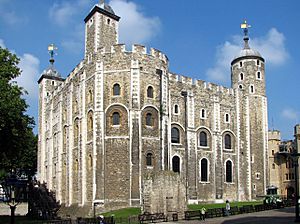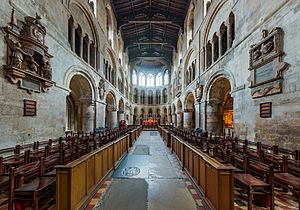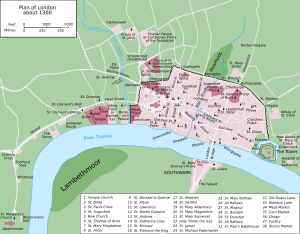Norman and Medieval London facts for kids
This article tells the story of London from the year 1066, when the Normans took over England, all the way to the end of the 1400s. It was a time of big changes for the city!
Contents
The Norman Takeover (1066)


The year 1066 marked a huge turning point in English history. William, the Duke of Normandy, led his army to victory against the English king Harold Godwinson at the Battle of Hastings.
After winning battles in Hampshire and Kent, William and his army headed towards London. They tried to cross London Bridge at Southwark but couldn't. So, William's army marched around London and waited at Berkhamsted.
The people of London soon realized that fighting back was pointless. A group from the city came to surrender and accept William as their new King. In 1067, William (now known as William the Conqueror) gave London a special charter. This charter promised to keep the old rights, benefits, and laws that the Saxon people had.
To protect London from sea attacks by Vikings and stop any rebellions, William built several royal forts along the river. These included the famous Tower of London, Baynard's Castle, and Montfichet's Castle. London gained more control over itself when King John gave the city the right to elect its own leaders in 1199 and 1215.
Famous Buildings of Medieval London

In 1097, William Rufus, who was William the Conqueror's third son, started building Westminster Hall. This hall became the main part of the Palace of Westminster. For hundreds of years during the Medieval period, this palace was the most important home for the kings and queens.
Around 1089, William gave land for Bermondsey Abbey. This abbey was founded in 1082 by Alwinus Child, a London citizen. It was built right across the River Thames from the White Tower, which was still being built at the time.
In 1123, the Augustinian Priory Church of St Bartholomew-the-Great was founded in West Smithfield in the City of London. Today, only the chancel (the part of the church near the altar) of this once-large church remains. But it's still a very important example of Norman architecture in London.
In 1176, work began on the most famous version of London Bridge. It was finished in 1209 and was built where several older wooden bridges had stood. This stone bridge lasted for 600 years! It was the only bridge across the River Thames until 1739.
Wars and Revolts in London
London was home to many Jewish people during this time. Sadly, in 1190, violence broke out against them. This happened after a rumor spread that the new King had ordered their attack.
In May 1216, London was taken over by a foreign army for the last time. This happened during the First Barons' War. Prince Louis of France marched through the streets to St Paul's Cathedral. People in the city and cathedral cheered him as their new ruler.
Many hoped he would free England from the harsh rule of King John. But this only lasted a short time. When King John died, the barons who supported Prince Louis decided to support an English king instead. Over the next few centuries, London slowly lost the strong French cultural and language influence that had been there since the Norman conquest. London, like Dover, played a big part in how the English language changed into what we now call Early Modern English.
In 1264, during the Second Barons' War, rebels led by Simon de Montfort took over London. They killed 500 Jewish people while trying to get hold of records about debts.
London's Jewish community was forced to leave England in 1290 by King Edward I. This event is known as the Edict of Expulsion. They went to France, Holland, and other places. Their property was taken, and many were robbed and even murdered as they left.
In 1381, London was invaded during the Peasants' Revolt. This revolt was led by Wat Tyler. A group of peasants stormed the Tower of London. They executed the Lord Chancellor, Archbishop Simon Sudbury, and the Lord Treasurer. The peasants looted the city and set many buildings on fire. The Lord Mayor, William Walworth, stabbed Wat Tyler to death in a fight at Smithfield. This ended the revolt.
During the Wars of the Roses, London strongly supported the Yorkist side. Henry VI, who belonged to the Lancaster family, had to leave London in 1456 because people in the capital were against him. He was later captured and held in the Tower of London for five years. In 1471, the Yorkist Edward IV finally captured London, and Henry was murdered. This established the Yorkist claim to the throne and ended the first part of the Wars of the Roses.
London Becomes England's Capital
In the early Middle Ages, England didn't have one fixed capital city. Kings and their courts moved from place to place. The closest thing to a capital was Winchester, where the royal treasury and financial records were kept.
This changed around 1200 when these important records were moved to Westminster. From then on, the royal government started to focus more and more on Westminster. It slowly became the real capital city.
In the Middle Ages, Westminster was a small town located upriver from the City of London. From the 1200s onwards, London grew into two distinct parts. Westminster became the royal capital and the center of government. Meanwhile, the City of London became the hub for business and trade. This difference can still be seen today! The area between these two parts became fully developed by 1600.
Trade and Business Growth
Trade and business steadily increased during the Middle Ages. As a result, London grew very quickly. In 1100, London's population was just over 15,000 people. By 1300, it had grown to about 80,000!
Trade in London was organized into different guilds. These guilds were like powerful clubs for different types of workers and merchants. They effectively controlled the city and even elected the Lord Mayor of London.
Fires and Plagues
Medieval London had narrow, winding streets. Most buildings were made from wood and straw, which caught fire easily. This meant fires were a constant danger. Also, sanitation (keeping the city clean) was very poor.
London lost at least half of its population during the terrible Black Death in the mid-1300s. Between 1348 and the Great Plague of 1666, there were sixteen outbreaks of plague in the city. In 1666, the Great Fire destroyed much of London inside the old city wall.
See also



